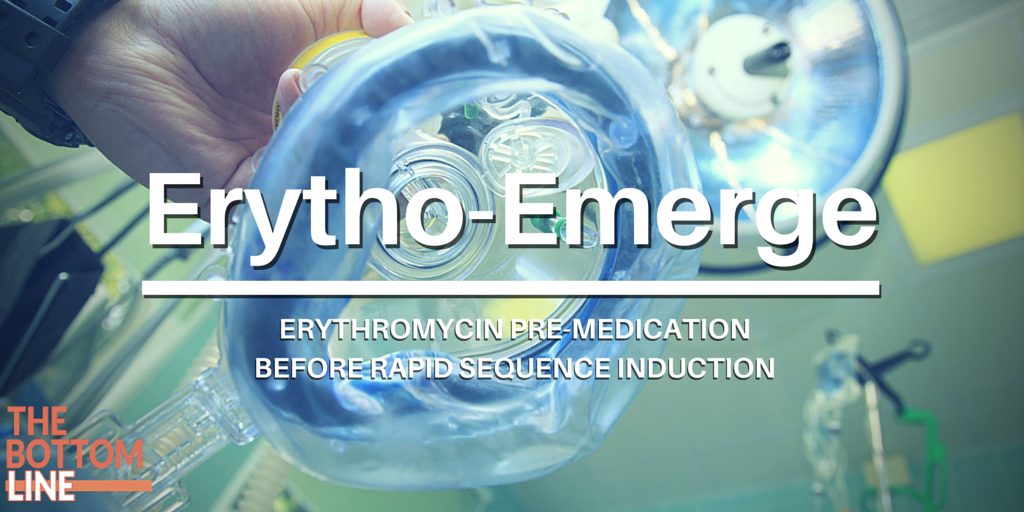Erythro-Emerge
Erythromycin for Gastric Emptying in Patients Undergoing General Anesthesia for Emergency Surgery
Czarnetzki. JAMA Surg. 2015; 150:730-7. doi:10.1001/jamasurg.2015.0306
Clinical Question
- In adult patients undergoing general anaesthesia for emergency surgery, does pre-medication with erythromycin compared to placebo reduce the volume of gastric content?
Design
- Single-centre, randomised, placebo-controlled trial
- Double blinded
- Randomisation sequence generated by hospital pharmacy and patients allocated on arrival in the operating room
- Concealment of sequence not specified
- Stratified by trauma status (trauma vs non-trauma)
- A power calculation was based upon a 30% baseline incidence of a clear stomach in the placebo group and an expected 80% incidence in the erythromycin group (absolute risk reduction 50%)
- 90% power
- Significance level 0.05
- 40 patients per group were required (increased to 50 to allow for lost data)
- However, recalculation of power calculation was performed as overall observed incidence of a clear stomach was 76%
- Maintained 90% and significance level 0.05
- Expected absolute risk reduction reduced to 30%
- Total 132 patients randomised
- Intention-to-treat analysis
Setting
- Single university hospital in Geneva
- March 2009 – April 2013
Population
- Inclusion: Adult patients requiring emergency surgery under general anaesthesia
- Exclusion: ASA > 3; GCS < 13; allergy to erythromycin or use of interacting drugs; significant comorbidity (including porphyria, liver or renal disease, severe asthma, exacerbated COPD, pneumonia, acute coronary disease, decompensated heart disease, aortic aneurysm, oesophageal disease, recent gastric surgery, obstructive ileus); presence of gastric tube or need for immediate surgical intervention; pregnancy or breastfeeding
- 569 patients assessed; 132 patients included; no lost data
Intervention
- Erythromycin
- 3 mg/kg erythromycin (made as 3mg/ml in NaCl 0.9% so that 1ml/kg solution was given) administered over 5 minutes given 15 minutes prior to induction of anaesthesia
Control
- Placebo
- 1ml/kg NaCl 0.9% as matched placebo administered over 5 minutes given 15 minutes prior to induction of anaesthesia
Management common to both
- Three minutes pre-oxygenation
- “Classic rapid-sequence procedure”
- Thiopental, propofol or etomidate
- Followed by suxamethonium or rocuronium
- Maintenance at anaesthetist’s discretion
- Gastroscopy by senior gastroenterologist
Outcome
- Primary outcome:
- Residual of less than 40 ml gastric liquid and the absence of solid food
- Erythromycin 80% vs Placebo 64%
- Risk ratio 1.26 (95% CI 1.01–1.57; P = 0.0518 using Fisher’s Exact)
- (RR > 1.0 favours erythromycin)
- Absolute risk reduction (ARR) 16.7% (95% CI 1.61–31.7%)
- Number needed to treat (NNT) 6
- Fragility Index 0 (zero)
- Sensitivity analysis with strict definition: completely empty stomach
- Erythromycin 62% vs Placebo 36%
- Risk ratio 1.67 (95% CI 1.15–2.42; P = 0.0055)
- ARR 24.2% (95% CI 7.7–40.8%)
- NNT 5
- Residual of less than 40 ml gastric liquid and the absence of solid food
- Sub-group analysis:
- Trauma: a statistically significant association between erythromycin and endoscopy findings was not found
- Non-trauma: a statistically significant association between erythromycin and endoscopy findings was found
- Secondary outcome: (as Erythromycin vs Placebo)
- Median acidity of residual gastric content:pH 2 vs 6 (P = 0.002)
- Median volume of residual gastric content: 27.5 ml vs 43.5 ml (P = 0.38)
- Safety outcomes: (as Erythromycin vs Placebo)
- Stomach cramps: 30% vs 6% (P < 0.001; absolute risk increase (ARI) 24.2%; number needed to harm (NNH) 5)
- Nausea: 23% vs 3% (P < 0.001; ARI 19.7%; NNH 6)
- Vomiting: 1.5% vs 0% (P = 1.0)
Authors’ Conclusions
- Erythromycin reduces residual gastric volume in patients undergoing emergency surgery under general anaesthesia with an acceptable side effect profile
Strengths
- Randomised and placebo-controlled
- Good randomisation method, concealment of allocation and blinding of patient, clinician and outcome assessor
- Revision of power calculation without revealing randomisation sequence
- Intention to treat analysis and complete follow-up
Weaknesses
- 569 patients screened for inclusion over 4 years in university hospital – is there a selection bias risk?
- Surrogate end-point
- Arguably regurgitation or aspiration should be the clinically important end-point but harder to study as rare
- It is difficult to conclude that lower residual volumes correlate to reduced aspiration volumes
- The only clinically meaningful endpoints measured were nausea and stomach cramps which were higher in the intervention arm.
- In non-trauma stratum, majority were undergoing appendicectomy or cholecystectomy – whilst these are common and may be majority of workload, this does reduce generalisability to other patient groups
- Numbers in trauma and non-trauma subgroups were two small for meaningful interpretation
- Trial excluded all high risk patient groups – findings are probably not generalisable to ASA > 3 patients or those critically unwell not requiring surgery
The Bottom Line
- This single centre RCT has methodological concerns that reduce the internal validity and external generalisability
- Erythromycin may reduce residual gastric content and acidity but this trial does not demonstrate sufficient statistical significance to reject the null hypothesis
- Any benefit occurs at the expense of unpleasant side effects with equal incidence to the intended benefit
- Whilst the authors should be commended for thinking laterally and investigating this novel idea, I shall not be using erythromycin prior to rapid sequence induction of anaesthesia
External Links
- [article] Erythromycin for Gastric Emptying in Patients Undergoing General Anesthesia for Emergency Surgery
- [further reading] Rapid Sequence Induction by BJA Education
- [further reading] Rapid Sequence Induction by LITFL
Metadata
Summary author: Duncan Chambler
Summary date: 21 June 2016
Peer-review editor: Celia Bradford




